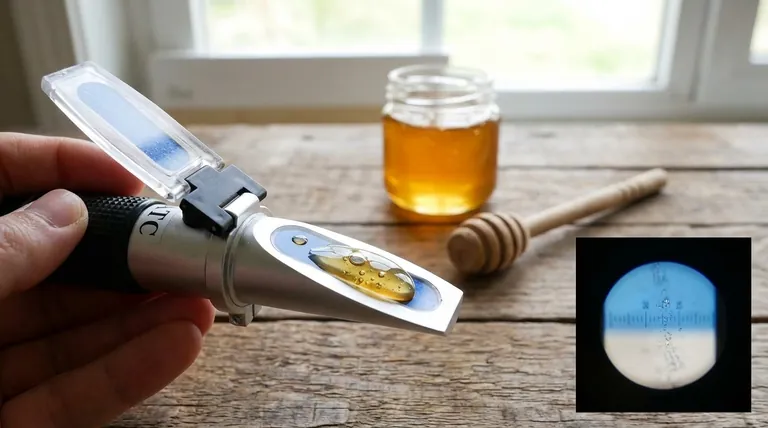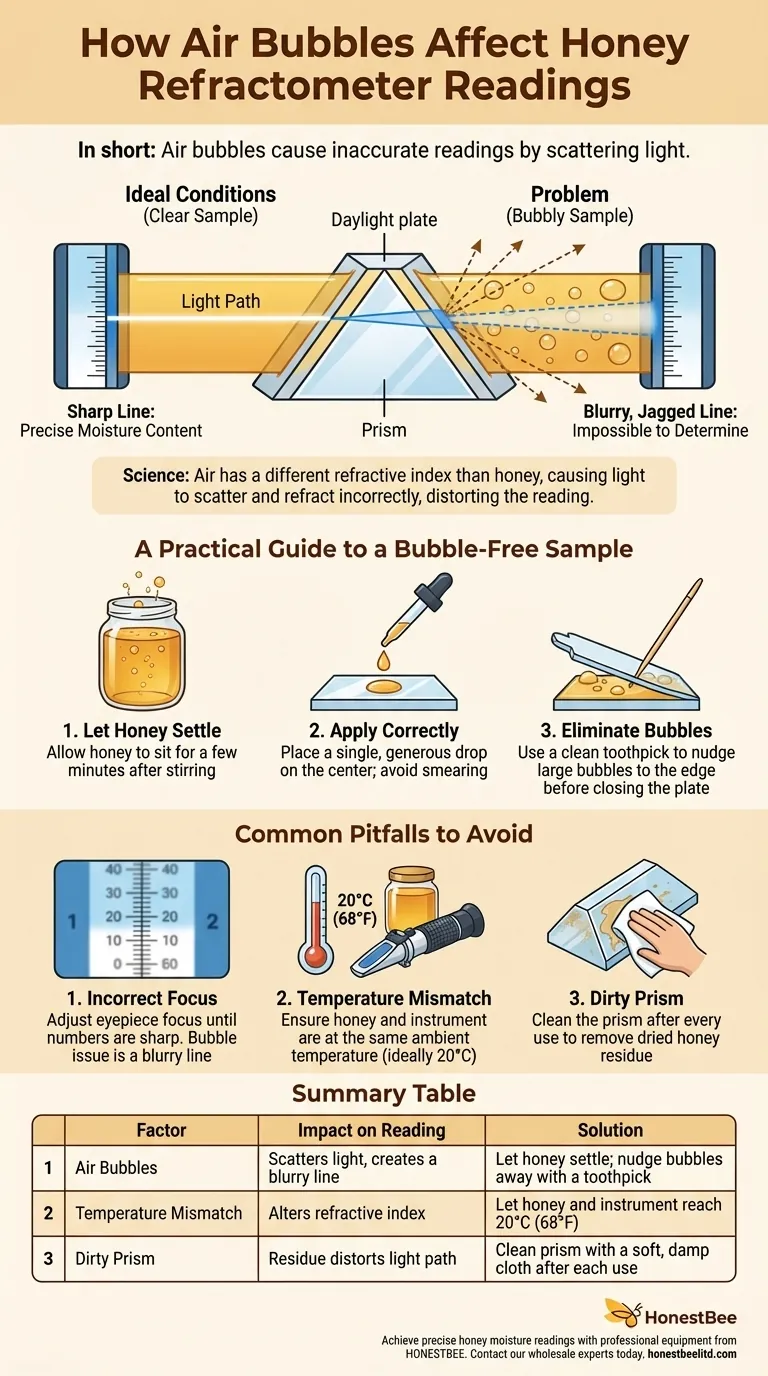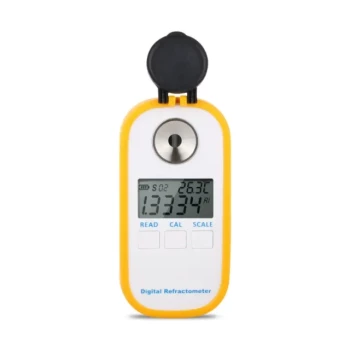In short, air bubbles will cause an inaccurate reading. Because a refractometer works by measuring how light bends through the honey, any bubbles trapped in the sample disrupt this path. This interference creates a blurry, fuzzy, or indistinct line between the light and dark sections of the viewing scale, making it impossible to determine the precise moisture content.
The core principle of refractometry is consistency. Any element that is not honey—be it an air bubble, a piece of debris, or residue from a previous test—will distort the light and compromise the accuracy of your measurement.

The Science Behind the Error: Light and Refraction
To understand why bubbles are a problem, you must first understand how the instrument works. It is a simple but precise optical device.
How a Refractometer Measures Moisture
A refractometer measures the refractive index of a substance. In simple terms, it measures how much a beam of light bends, or refracts, as it passes from the prism into your honey sample.
The amount of bending is directly related to the density of the honey. Because water is less dense than honey solids, a higher water content will cause the light to bend at a different angle than honey with a lower water content. The instrument's scale is calibrated to translate this angle directly into a moisture percentage.
Why Air Bubbles Cause Distortion
Air has a vastly different refractive index than honey. When an air bubble is trapped between the prism and the daylight plate, it creates a non-uniform layer.
Instead of light passing cleanly through a single medium (honey), it hits pockets of air. This causes the light to scatter and refract incorrectly, resulting in a blurry or jagged shadow line in the eyepiece. You cannot trust a reading from a sample with visible bubbles in the light path.
A Practical Guide to a Bubble-Free Sample
Achieving an accurate reading is about careful preparation and application. The goal is a thin, uniform layer of honey on the prism.
Prepare the Honey First
If your honey has been recently stirred, poured, or agitated, it will be full of tiny, suspended air bubbles. For the most accurate results, allow the honey to sit for a few minutes to let some of these bubbles rise to the surface.
Apply the Sample Correctly
Place a single, generous drop of honey onto the center of the clean prism. Avoid scraping or smearing the honey, as this action can introduce new air bubbles directly onto the measurement surface.
Eliminate Visible Bubbles
After closing the daylight plate, hold the refractometer up to a light source and look through the eyepiece. If you see large bubbles interfering with the reading line, you must remove them.
Gently lift the plate and use the tip of a clean toothpick or the corner of your sample dropper to carefully nudge the bubbles to the edge of the prism, away from the central viewing area. Then, close the plate and check again.
Common Pitfalls to Avoid
Bubbles are a primary culprit for bad readings, but they are not the only one. Being aware of other common errors is key to achieving true accuracy.
Pitfall 1: Incorrect Focus vs. Bubbles
A blurry reading line is not always caused by bubbles. If the entire scale, including the numbers, appears out of focus, simply twist the eyepiece to adjust the focus until the image is sharp. A bubble-related issue is typically a fuzzy or distorted line, while the scale numbers remain clear.
Pitfall 2: Temperature Mismatch
This is one of the most overlooked sources of error. Most honey refractometers are calibrated to read accurately at a specific temperature, usually 20°C (68°F). If your honey is warmer or colder than the instrument, the reading will be incorrect. For precise work, allow both the honey sample and the refractometer to sit at room temperature for several minutes to equalize.
Pitfall 3: A Dirty Prism
Always clean the prism and daylight plate with a soft, damp cloth immediately after each use. Dried honey residue from a previous test will alter the refractive index and guarantee an inaccurate reading on your next sample.
How to Ensure an Accurate Reading Every Time
Use this checklist to build confidence in your process and your results.
- If your primary focus is a quick, reliable reading: Ensure the prism is clean, apply a single drop of honey, and gently move any large bubbles away from the center of the prism before taking your measurement.
- If your primary focus is scientific precision for sales or grading: In addition to removing all bubbles, you must allow both your honey and your refractometer to stabilize at the same ambient temperature (ideally 20°C / 68°F) before testing.
By controlling these simple variables, you can have complete confidence in your honey's moisture measurement.
Summary Table:
| Factor | Impact on Reading | Solution |
|---|---|---|
| Air Bubbles | Scatters light, creates a blurry line | Let honey settle; nudge bubbles away with a toothpick |
| Temperature Mismatch | Alters refractive index | Let honey and instrument reach 20°C (68°F) |
| Dirty Prism | Residue distorts light path | Clean prism with a soft, damp cloth after each use |
Achieve precise honey moisture readings with professional equipment from HONESTBEE. Inaccurate measurements can impact honey quality, grading, and sales. We supply durable, high-precision refractometers and other essential beekeeping supplies to commercial apiaries and distributors. Ensure your operation's success with reliable tools. Contact our wholesale experts today to discuss your equipment needs.
Visual Guide

Related Products
- Precision Honey Refractometer Instrument for Quality Assessment
- Digital Honey Refractometer for Precision Measurement of Optimal Honey Quality
- 8-Frame Electric Self-Reversing Honey Extractor Spinner for Commercial Honey Extraction Equipment
- HONESTBEE 3-Frame Manual Acrylic Honey Extractor
- Professional Thermostatic Conical Honey Melter
People Also Ask
- What are the key points for proper usage of a honey refractometer? Ensure Accurate Moisture Readings Every Time
- Why is a honey refractometer essential for honey harvesting? Protect Your Harvest from Spoilage
- What are the key steps to using a honey refractometer? Ensure Honey Quality & Prevent Fermentation
- What are the benefits of using a Pocket Digital Honey Refractometer? Achieve Precision & Speed in Honey Quality Control
- Why is a honey refractometer important for beekeepers? Ensure Quality and Prevent Fermentation



















